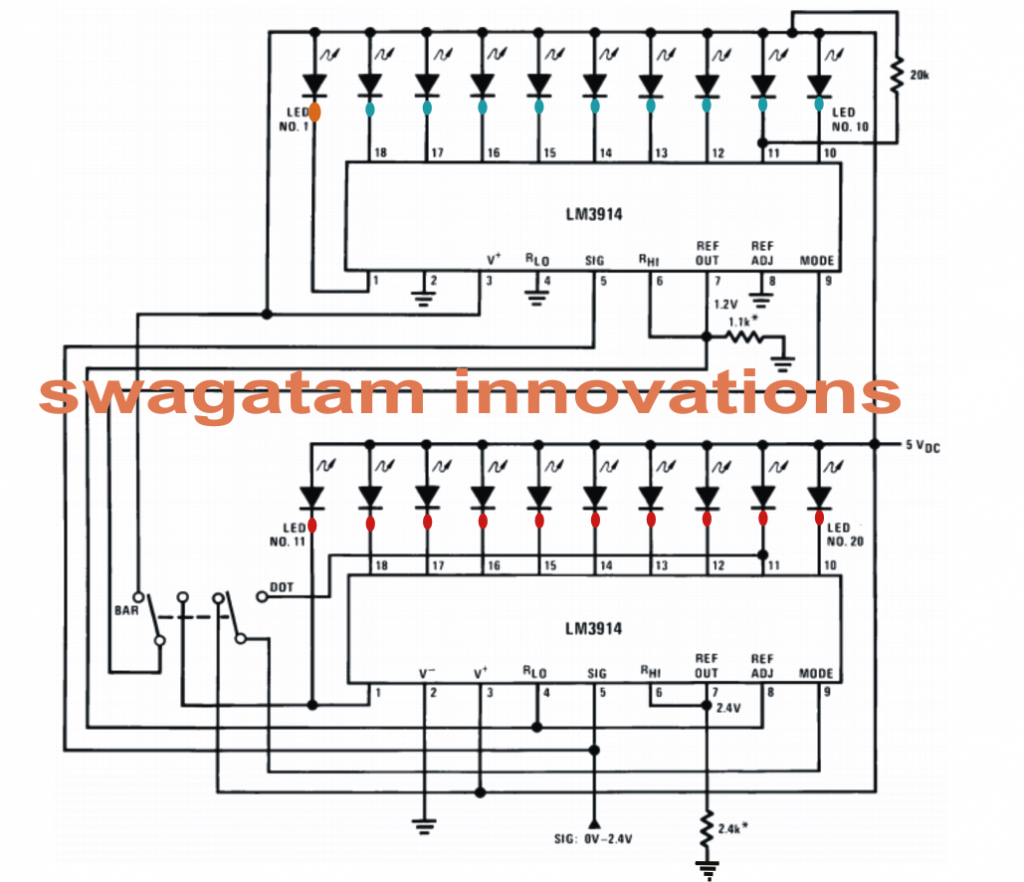In this post I have explained a simple electronic load controller or governor circuit which automatically regulates and controls the rotational speed of a hydro-electric generator system by adding or deducting an array of dummy loads. The procedure ensures a stabilized voltage and frequency output for the user. The idea was requested by Mr. Aponso
Technical Specifications:
Thanks for reply and I was out of country for two weeks. Thanks for info and timer circuit is working very fine now.
Case II , I need electronic Load Controller(ELC)My hydro power plant is 5 kw single phase 220V and 50Hz and need to control excess power using ELC. Please give reliable circuit for my requirement
Aponso
The Design
If you are one of those lucky people who have a free flowing creek, river stream or even an active small water fall near your backyard, you can very well think of converting it into free electricity simply by installing a mini hydro generator in path of the water flow, and access free electricity for lifetime.
However the main problem with such systems is the speed of the generator which directly affects its voltage and frequency specs.
Here, the rotational speed of the generator depends on two factors, the power of the water flow and the load connected with the generator. If any of these alter, the speed of the generator too alters causing an equivalent decrease or increase in its output voltage and frequency.
As we all know that for many appliances are such as refrigerators, ACs, motors, drill machines, etc voltage and frequency can be crucial and may be directly related to their efficiency, thus any change in these parameters cannot be taken lightly.
In order to tackle the above situation so that the voltage and the frequency both are maintained within tolerable limits, an ELC or electronic load controller is normally employed with all hydro power systems.
Since controlling water flow cannot be a feasible option, controlling load in a calculated manner becomes the only way out for the above discussed issue.
This is in fact rather straightforward, it's all about employing a circuit which monitors the voltage of the generator and switches ON or OFF a few dummy loads which in turn control and compensate for the increase or decrease in the speed of the generator.
Two simple electronic load controller (ELC) circuits are discussed below (designed by me) which can be easily built at home and used for the proposed regulation of any mini hydro power station. I have explained their operations with the following points:
ELC Circuit using IC LM3915
The first circuit which uses a couple of cascaded LM3914 or LM3915 ICs are basically configured as a 20 step voltage detector driver circuit.
A varying 0 to 2.5V DC input at its pin#5 produces an equivalent sequential response across the 20 outputs of the two ICs, starting from LED#1 to LED#20, meaning at 0.125V, the first LED lights up. while as the input reaches 2.5V, the 20th LED lights up (all LEDs lit up).
Anything in between results in toggling of the corresponding intermediate LED outputs.
Let's assume the generator to be with 220V/50Hz specs, means the lowering its speed would result in lowering of the specified voltage as well as the frequency, and vice versa.
In the proposed first ELC circuit, we reduce the 220V to the required low potential DC via a resistor divider network and feed pin#5 of the IC such that the first 10 LEDs (LED#1 and rest of the blue points) just illuminate.
Now these LED pinouts (from LED#2 to LED#20) are also attached with individual dummy loads via individual mosfet drivers, in addition to the domestic load.
The domestic useful loads are connected via a relay on LED#1 output.
In the above condition it assures that at 220V while all the domestic loads are in use, 9 additional dummy loads also illuminate, and compensate to produce the required 220V @50Hz.
Now suppose the speed of the generator tends to rise above the 220V mark, this would influence pin#5 of the IC which would correspondingly switch the LEDs marked with red dots (from LED#11 and upwards).
As these LEDs are switched ON, the corresponding dummy loads get added to the fray thereby squeezing the speed of the generator such that it gets restored to its normal specs, as this happens the dummy loads are again switched OFF in back sequence, this goes on self-adjusting such that the speed of the motor never exceeds the normal ratings.
Next, suppose the motor speed tends to decreases due to lower water flow power, LEDs marked with blue start shutting off sequentially (starting from LED#10 and downward), this reduces the dummy loads and in turn relieves the motor from excess load thereby restoring its speed toward the original point, in the process the loads tend to switch ON/OFF sequentially in order to maintain the exact recommended speed of the generator motor.
The dummy loads may be selected as per user preference, and conditional specs. An increment of 200 watts on each LED output would probably be most favorable.
The dummy loads must be resistive in nature, such as 200 watt incandescent lamps or heater coils.
Circuit Diagram
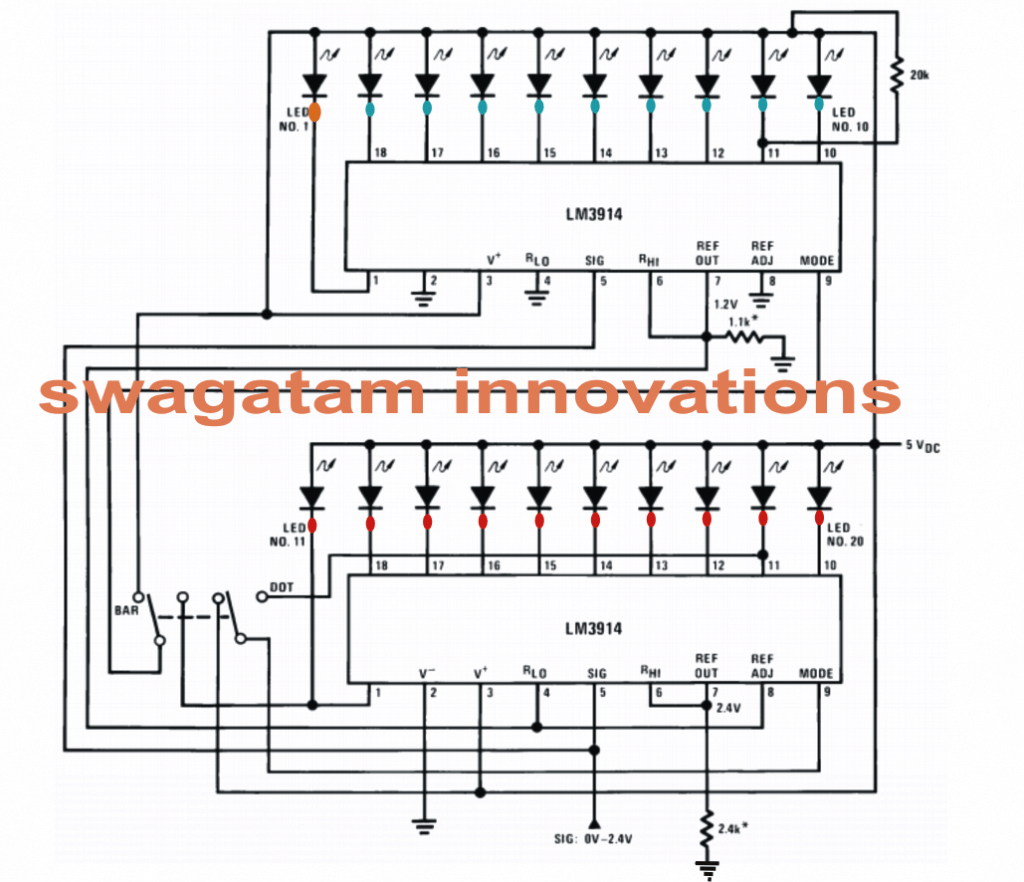
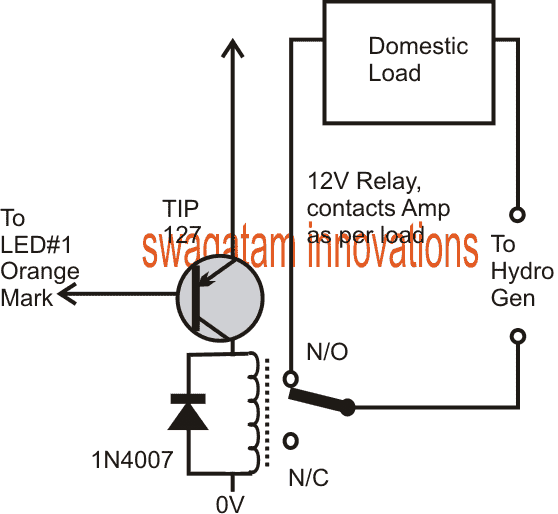
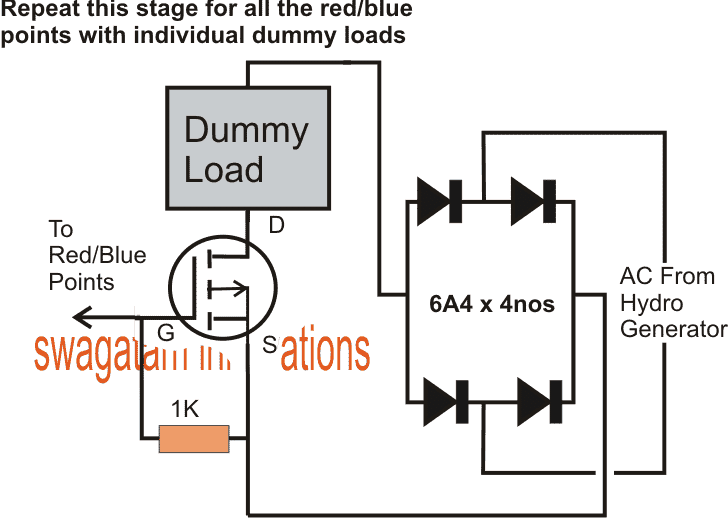
ELC Circuit using PWM
The second option is rather very interesting and even more simpler. As can be seen in the given diagram, a couple of 555 ICs are used as a PWM generator which alters its mark/space ration in response to the correspondingly varying voltage level fed at pin#5 of IC2.
A well calculated high wattage dummy load is attached with a sole mosfet controller stage at pin#3 of IC#2.
As discussed in the above section, here too a lower sample DC voltage corresponding to 220V is applied at pin#5 of IC2 such that the dummy loads illuminations adjust with the domestic loads to hold the generator output within the 220V range.
Now suppose the rotational speed of the generator drifts towards the higher side, would create an equivalent rise in potential at pin#5 of IC2 which in turn would give rise to higher mark ratio to the mosfet, allowing it to conduct more current to the load.
With increase in the load current, the motor would find it harder to rotate thus settling down back to its original speed.
Exactly the opposite happens when the speed tends to drift toward lower levels, when the dummy load is weakened in order to pull up the speed of the motor to its normal specs.
A constant "tug-of-war" continues so that the speed of the motor never shifts too much from its required specifications.
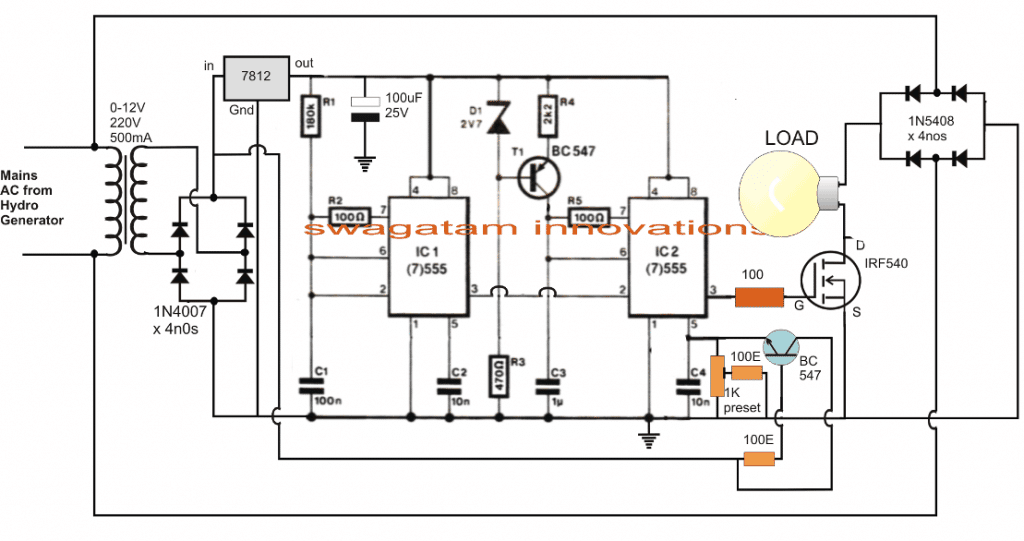
The above ELC circuits can be used with all types of microhydro systems, watermill systems and also wind mill systems.
Now let's see how we can employ a similar ELC circuit for regulating the speed and frequency of a windmill generator unit. The idea was requested by Mr. Nilesh Patil.
Technical Specifications
I am Great fan of your Electronic circuits and Hobby to create it. Basically i'm from rural area where 15 hours power cut off problem we facing every year
Even if i go for to buy inverter that is also not get charged due to power failure.
I have created wind mill generator (In Very Cheap Cost ) from that will support to charge 12 v battery.
For the same i m looking to buy wind mill charge turbine Controller that is too costly.
So planned to create our own if have suitable design from you
Generator Capacity : 0 - 230 AC Volt
input 0 - 230 v AC (Vary depends on wind speed)
output : 12 V DC (sufficient boost up current).
Overload / Discharge / Dummy Load handling
Can you please suggest or help me to develop it and required component & PCB from you
I May required many same circuit once succeed.
The Design
The design requested above can be implemented simply by using a step down transformer and a LM338 regulator as already discussed in many of my posts earlier.
The circuit design I have explained below is not relevant to the above request, rather addresses a much complex issue in situations where a windmill generator is used for operating AC loads assigned with mains 50Hz or 60Hz frequency specifications.
How an ELC Works
An electronic load controller is a device which frees or chokes up the speed of an associated electricity generator motor by adjusting the switching of a group of dummy or dump loads connected parallel with the actual usable loads.
The above operations become necessary because the concerned generator may be driven by an irregular, varying source such as a flowing water from a creek, river, waterfall or through wind.
Since the above forces could vary significantly depending upon the associated parameters governing their magnitudes, the generator could also be forced to increase or decrease its speed accordingly.
An increase in speed would mean an increase in voltage and frequency which in turn could be subjected to the connected loads, causing undesirable effects and damage to the loads.
Adding Dump Loads
By adding or deducting external loads (dump loads) across the generator, its speed could be effectively countered against the forced source energy such that the generator speed is maintained approximately to the specified levels of frequency and voltage.
I have already discussed a simple and effective electronic load controller circuit in one of my previous posts, the present idea is inspired from it and is quite similar to that design.
The figure below shows how the proposed ELC may be configured.
The heart of the circuit is the IC LM3915 which is basically a dot/bar LED driver used for displaying variations in the fed analogue voltage input through sequential LED illuminations.
The above function of the IC has been exploited here for implementing the ELC functions.
The generator 220V is first stepped down to 12V DC through a step down transformer and is used for powering the electronic circuit consisting the IC LM3915 and the associated network.
This rectified voltage is also fed to pin#5 of the IC which is the sensing input of the IC.
Generating Proportionate Sensing Voltages
If we assume the 12V from the transformer to be proportionate with 240V from the generator, implies that if the generator voltage rises to 250V would increase the 12V from the transformer proportionately to:
12/x = 240/250
x = 12.5V
Similarly if the generator voltage drops to 220V would proportionately drop the transformer voltage to:
12/x = 240/220
x = 11V
and so on.
The above calculations clearly show that the RPM, frequency and voltage of the generator are extremely linear and proportionate to each other.
In the proposed electronic load controller circuit design below, the rectified voltage fed to pin#5 of the IC is adjusted such that with all the usable loads switched ON, only three dummy loads: lamp#1, lamp#2 and lamp#3 are allowed to remain switched ON.
This becomes a reasonably controlled set up for the load controller, of course the adjustment variations range could be set up and adjusted to different magnitudes depending upon the users preferences and specifications.
This may be done by randomly adjusting the given preset at pin#5 of the IC or by using different sets of loads across the 10 outputs of the IC.
Setting up the ELC
Now with the above mentioned set-up let's assume the generator to be running at 240V/50Hz with the first three lamps in the IC sequence switched ON, and also all the external usable loads (appliances) switched ON.
Under this situation if a few of the appliances are switched OFF would relieve the generator from some load resulting in an increase in its speed, however the increase in the speed would also create an proportionate increase in voltage at pin#5 of the IC.
This will prompt the IC to switch ON its subsequent pinouts in the order thereby switching ON may be lamp#4,5,6 and so on until the speed of the generator is choked up in order to sustain the desired assigned speed and frequency.
Conversely, suppose if the generator speed tends to sow down due to degrading source energy conditions would prompt the IC to switch OFF lamp#1,2,3 one by one or a few of them in order to prevent the voltage from falling below the set, correct specifications.
The dummy loads are all terminated sequentially via PNP buffer transistor stages and the subsequent NPN power transistor stages.
All the PNP transistors are 2N2907 while the NPN are TIP152, which could be replaced with N-mosfets such as IRF840.
Since the above mentioned devices work only with DC, the generator output is suitably converted to DC via 10amp diode bridge for the required switching.
The lamps could be 200 watt rated, 500 watt rated or as preferred by the user, and the generator specs.
Circuit Diagram
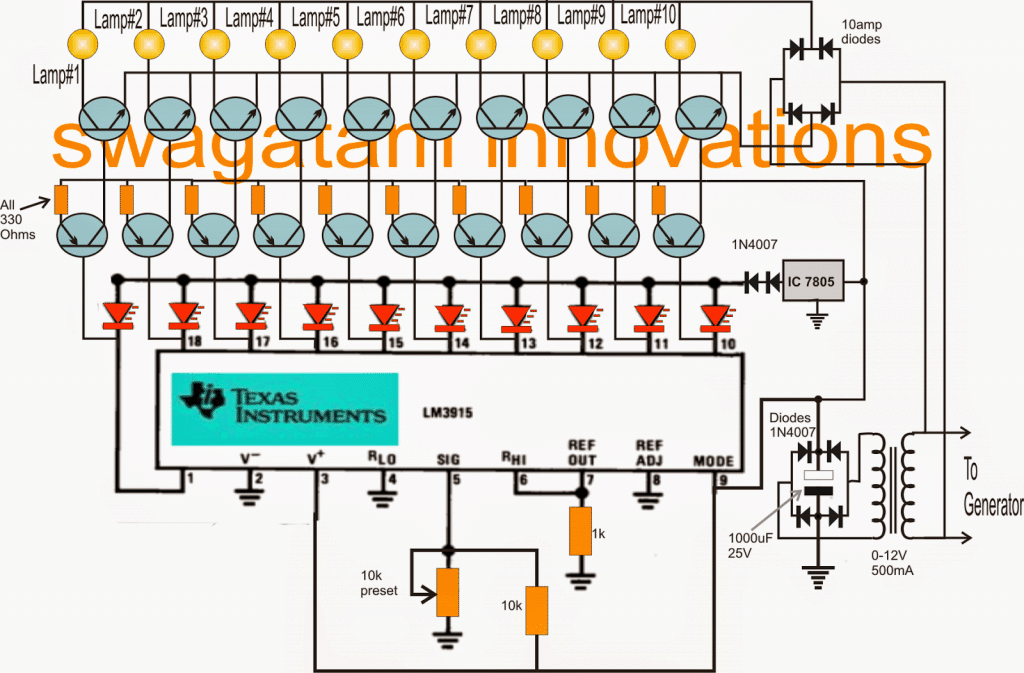
So far I have explained an effective electronic load controller circuit using a sequential multiple dummy load switcher concept, here I have explained a much simpler design of the same using a triac dimmer concept and with a single load.
What's a Dimmer Switch
A dimmer switch device is something we all are familiar with and can see them installed in our homes, offices, shops, malls etc.
A dimmer switch is a mains operated electronic device which can be used for controlling an attached load such as lights and fans simply by varying an associated variable resistance called a pot.
The control is basically done by a triac which is forced to switch with an induced time delay frequency such that it remains ON only during a fraction of the AC half cycles.
This switching delay is proportionate with the adjusted pot resistance and changes as the pot resistance is varied.
Thus if the pot resistance is made low, the triac is allowed to conduct for a longer time interval across the phase cycles which allows more current to pass through the load, and this in turn allows the load to activate with more power.
Conversely if the pot resistance is reduced, the triac is restricted to conduct proportionately for a much smaller section of the phase cycle, making the load weaker with its activation.
In the proposed electronic load controller circuit the same concept is applied, however here the pot is replaced with an opto coupler made by concealing an LED/LDR assembly inside a light proof sealed enclosure.
Using Dimmer Switch as ELC
The concept is actually pretty simple:
The LED inside the opto is driven by a proportionately dropped voltage derived from the generator output, meaning the LED brightness now is dependent on the voltage variations of the generator.
The resistance which is responsible for influencing the triac conduction is substituted by the LDR inside the opto assembly, meaning the LED brightness levels now becomes responsible for adjusting the triac conduction levels.
Initially, the ELC circuit is applied with a voltage from the generator running at 20% more speed than its correct specified rate.
A reasonably calculated dummy load is attached in series with the ELC, and P1 is adjusted such that the dummy load slightly illuminates and adjusts the generator speed and frequency to the correct level as per the required specs.
This is executed with all the external appliances in a switched ON position, that may be associated with the generator power.
The above implementation sets up the controller optimally for tackling any discrepancy created in the speed of the generator.
Now suppose, if a few of the appliances are switched OFF, this would create a low pressure on the generator forcing it to spin faster and generate more electricity.
However this would also force the LED inside the opto to grow proportionately brighter, which in turn would decrease the LDR resistance, thereby forcing the triac to conduct more and drain the excess voltage through the dummy load proportionately.
The dummy load which is obviously an incandescent lamp could be seen glowing relatively brighter in this situation, draining the extra power generated by the generator and restoring the generator speed to its original RPM.
Circuit Diagram
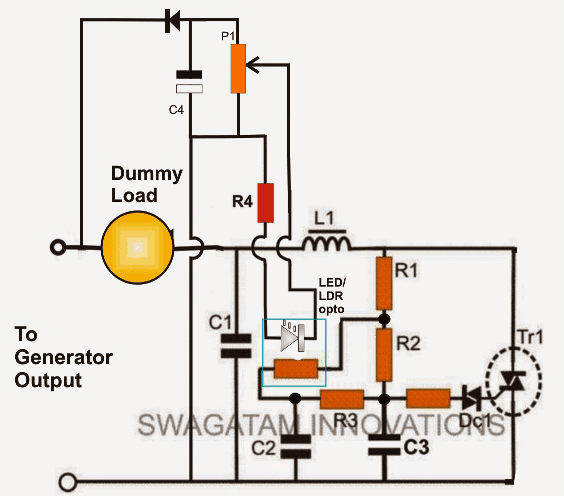
Parts List for the single dummy load, electronic load controller circuit
- R1 = 15K,
- R2 = 330K
- R3 = 33K
- R4 = 47K 2 WATT
- R5 = 47 OHMS
- P1 = 100K 1 WATT PRESET
- C1 = 0.1uF/1KV
- C2,c3 = 0.047uF/250V
- OPTO = ASSEMBLY OF WHITE HIGH BRIGHT 5MM LED, AND A SUITABLE LDR
- L1 = 100mH, 20 AMP FERRITE CORE INDUCTOR
- DUMMY LOAD = 2000 WATT LAMP
- DC= DIAC DB-3 BIG
- TR1 = TRIAC BTA41/600
